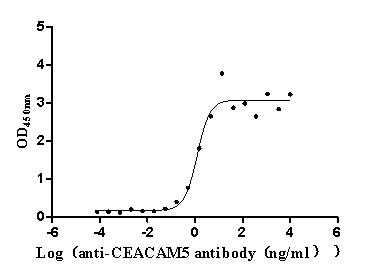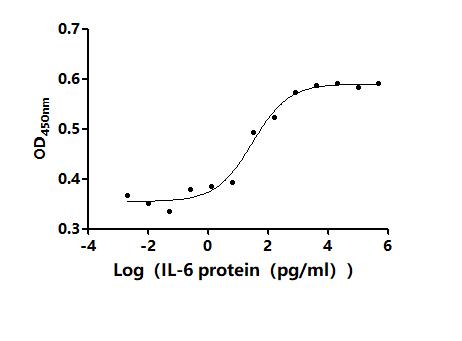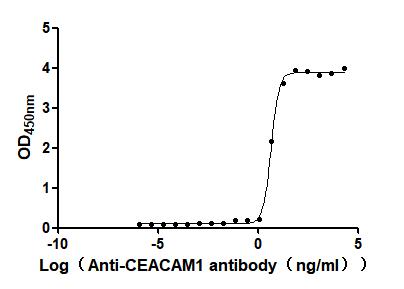Recombinant Mouse POU domain, class 4, transcription factor 2 (Pou4f2)
-
中文名称:小鼠Pou4f2重组蛋白
-
货号:CSB-YP733978MO
-
规格:
-
来源:Yeast
-
其他:
-
中文名称:小鼠Pou4f2重组蛋白
-
货号:CSB-EP733978MO
-
规格:
-
来源:E.coli
-
其他:
-
中文名称:小鼠Pou4f2重组蛋白
-
货号:CSB-EP733978MO-B
-
规格:
-
来源:E.coli
-
共轭:Avi-tag Biotinylated
E. coli biotin ligase (BirA) is highly specific in covalently attaching biotin to the 15 amino acid AviTag peptide. This recombinant protein was biotinylated in vivo by AviTag-BirA technology, which method is BriA catalyzes amide linkage between the biotin and the specific lysine of the AviTag.
-
其他:
-
中文名称:小鼠Pou4f2重组蛋白
-
货号:CSB-BP733978MO
-
规格:
-
来源:Baculovirus
-
其他:
-
中文名称:小鼠Pou4f2重组蛋白
-
货号:CSB-MP733978MO
-
规格:
-
来源:Mammalian cell
-
其他:
产品详情
-
纯度:>85% (SDS-PAGE)
-
基因名:Pou4f2
-
Uniprot No.:
-
别名:Pou4f2; Brn-3.2; Brn3b; POU domain; class 4; transcription factor 2; Brain-specific homeobox/POU domain protein 3B; Brain-3B; Brn-3B; Brn-3.2
-
种属:Mus musculus (Mouse)
-
蛋白长度:full length protein
-
表达区域:1-411
-
氨基酸序列MMMMSLNSKQ AFSMPHAGSL HVEPKYSALH SASPGSSAPA APSASSPSSS SNAGGGGGGG GGGGGGGRSS SSSSSGSGGS GGGGGSEAMR RACLPTPPSN IFGGLDESLL ARAEALAAVD IVSQSKSHHH HPPHHSPFKP DATYHTMNTI PCTSAASSSS VPISHPSALA GTHHHHHHHH HHHHQPHQAL EGELLEHLSP GLALGAMAGP DGTVVSTPAH APHMATMNPM HQAALSMAHA HGLPSHMGCM SDVDADPRDL EAFAERFKQR RIKLGVTQAD VGSALANLKI PGVGSLSQST ICRFESLTLS HNNMIALKPI LQAWLEEAEK SHREKLTKPE LFNGAEKKRK RTSIAAPEKR SLEAYFAIQP RPSSEKIAAI AEKLDLKKNV VRVWFCNQRQ KQKRMKYSAG I
-
蛋白标签:Tag type will be determined during the manufacturing process.
The tag type will be determined during production process. If you have specified tag type, please tell us and we will develop the specified tag preferentially. -
产品提供形式:Lyophilized powder
Note: We will preferentially ship the format that we have in stock, however, if you have any special requirement for the format, please remark your requirement when placing the order, we will prepare according to your demand. -
复溶:We recommend that this vial be briefly centrifuged prior to opening to bring the contents to the bottom. Please reconstitute protein in deionized sterile water to a concentration of 0.1-1.0 mg/mL.We recommend to add 5-50% of glycerol (final concentration) and aliquot for long-term storage at -20℃/-80℃. Our default final concentration of glycerol is 50%. Customers could use it as reference.
-
储存条件:Store at -20°C/-80°C upon receipt, aliquoting is necessary for mutiple use. Avoid repeated freeze-thaw cycles.
-
保质期:The shelf life is related to many factors, storage state, buffer ingredients, storage temperature and the stability of the protein itself.
Generally, the shelf life of liquid form is 6 months at -20°C/-80°C. The shelf life of lyophilized form is 12 months at -20°C/-80°C. -
货期:Delivery time may differ from different purchasing way or location, please kindly consult your local distributors for specific delivery time.Note: All of our proteins are default shipped with normal blue ice packs, if you request to ship with dry ice, please communicate with us in advance and extra fees will be charged.
-
注意事项:Repeated freezing and thawing is not recommended. Store working aliquots at 4°C for up to one week.
-
Datasheet :Please contact us to get it.
靶点详情
-
功能:Tissue-specific DNA-binding transcription factor involved in the development and differentiation of target cells. Functions either as activator or repressor by modulating the rate of target gene transcription through RNA polymerase II enzyme in a promoter-dependent manner. Binds to the consensus octamer motif 5'-AT[A/T]A[T/A]T[A/T]A-3' of promoter of target genes. Plays a fundamental role in the gene regulatory network essential for retinal ganglion cell (RGC) differentiation. Binds to an octamer site to form a ternary complex with ISL1; cooperates positively with ISL1 and ISL2 to potentiate transcriptional activation of RGC target genes being involved in RGC fate commitment in the developing retina and RGC axon formation and pathfinding. Inhibits DLX1 and DLX2 transcriptional activities preventing DLX1- and DLX2-mediated ability to promote amacrine cell fate specification. In cooperation with TP53 potentiates transcriptional activation of BAX promoter activity increasing neuronal cell apoptosis. Negatively regulates BAX promoter activity in the absence of TP53. Acts as a transcriptional coactivator via its interaction with the transcription factor ESR1 by enhancing its effect on estrogen response element (ERE)-containing promoter. Antagonizes the transcriptional stimulatory activity of POU4F1 by preventing its binding to an octamer motif. Involved in TNFSF11-mediated terminal osteoclast differentiation.
-
基因功能参考文献:
- Dlx1 and Dlx2 function both downstream of ATOH7 and in parallel, but cooperative, pathways that involve regulation of Brn3b expression to determine retinal ganglion cell fate. PMID: 28356311
- he present Pou4f2-GFP knock-in mouse line is a useful tool for further studies on the differentiation and regeneration of retinal ganglion cells PMID: 27532212
- Strongylocentrotus purpuratus Pou4f1/2 and mouse Pou4f2 share conserved components of a gene network for photosensory development and they maintain their conserved intrinsic functions despite vast morphological differences in mouse and sea urchin photosensory structures. PMID: 26962139
- Dynamic expression of Brn3b was identified in the somatosensory component of cranial nerves during different stages of development. PMID: 26356988
- transient expression ofFezf2in the retina modulates the transcription ofBrn3band the survival of RGCs. PMID: 26861874
- Pou4f2 KO mice exhibit profound hyperglycemia, increased GSK3B expression, and decreased GLUT4 expression. In C2C12 myocytes, Pou4f2 mRNA and protein are induced by glucose and inhibited by insulin. PMID: 26670484
- Results suggest the existence of a coordinated mechanism by miR-23a and miR-374 to down regulate Brn3b and ultimately regulate the development of retinal ganglion cells from their precursors PMID: 24838392
- Increased Brn-3b and p53 correlated with elevated expression of pro-apoptotic target genes, Bax, Noxa and PUMA, whereas cleaved caspase-3 confirmed the presence of apoptotic cells within this region of the injured heart. PMID: 25356872
- Brn3b is expressed in a subset of intrinsically photosensitive retinal ganglion cells PMID: 21935940
- Brn-3b suppresses the role of DLX1/2 through physical interaction and biases the competent precursors toward retinal ganglion cell fates. PMID: 21875655
- Generalized retinal ganglion cell and combined nerve fiber layer and inner plixiform layer loss was observed in Brn3b(-/-) retinas PMID: 21622702
- Brn3b regulates gene expression through the action of a strong transcriptional activation domain within its N-terminal sequence. PMID: 15733064
- Eomes is a crucial regulator positioned immediately downstream of Pou4f2 and is required for retinal ganglion cell differentiation and optic nerve development. PMID: 18077589
- Math5 and Brn3b double null mice exhibit over a 99% reduction in the number of retinal ganglion cells during development. PMID: 18321480
- Loss of Brn3b leads to loss of 70% of RGCs, disorganization of axonal structure in the eye and brain, and and severely impairs the vertical OKR and compromises light-dependent pupil constriction and photo-entrainment. PMID: 19323995
- Data found that Math5 and Pou4f2 were transiently co-expressed in newly born RGCs, unequivocally demonstrating that Pou4f2 is immediately downstream of Math5 in RGC formation. PMID: 19459208
显示更多
收起更多
-
亚细胞定位:Nucleus. Nucleus speckle. Cytoplasm.
-
蛋白家族:POU transcription factor family, Class-4 subfamily
-
组织特异性:Expressed in retinal ganglion cells (RGCs). Expressed in mature osteoclasts. Expressed in cells of layers of the superior colliculus and the adjacent periaqueductal gray (at protein level). Expressed in the brain, peripheral sensory nervous system and ret
-
数据库链接:
Most popular with customers
-
Express system: Mammalian cell
Species: Homo sapiens (Human)
-
-
Recombinant Human Tumor necrosis factor ligand superfamily member 15(TNFSF15) (Active)
Express system: Mammalian cell
Species: Homo sapiens (Human)
-
Express system: Mammalian cell
Species: Homo sapiens (Human)




-AC1.jpg)










